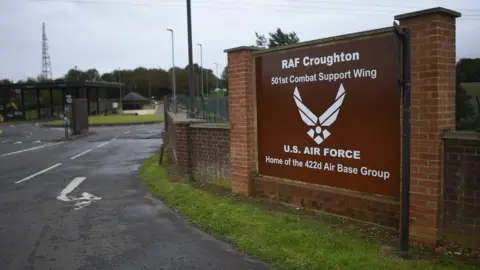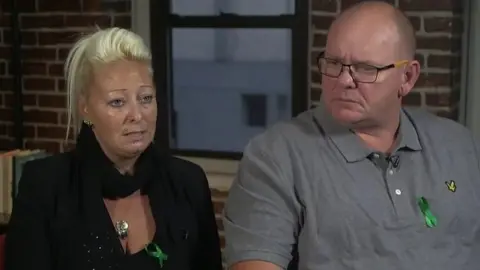Harry Dunn death: Is extraditing Anne Sacoolas a realistic prospect?
 Justice4Harry19
Justice4Harry19Harry Dunn's grieving family is desperate to know what happened in their son's final moments. The person who can provide those details and give them some degree of closure, is Anne Sacoolas, the American woman suspected of driving the car involved in the fatal crash.
Mrs Sacoolas, 42, returned to the United States days after the crash which killed 19-year-old Harry. At the time, she had diplomatic immunity, but both the British and US governments agree she no longer has.
Charlotte Charles and Tim Dunn travelled to Washington this week to meet Donald Trump but rejected a meeting at the White House with Mrs Sacoolas, saying they felt "a little ambushed" when the president revealed she was in the next room.
They want to meet her in the UK with professional mediators and counsellors in attendance, but so far, Mrs Sacoolas has refused to leave the US. So, what are the legal options that might provide Harry's parents with the meeting and the details of their son's death?
Can Anne Sacoolas be extradited?
 Aiken Standard Archive
Aiken Standard ArchiveIn order for Mrs Sacoolas to be extradited from the US, she firstly would need to be charged by the Crown Prosecution Service (CPS) with a criminal offence which is serious enough to warrant it.
Prosecutors will make a decision once they have been passed the case file by the police who have investigated and gathered all the available relevant evidence.
The decision to charge is made if - based on that evidence - there is a realistic prospect of conviction (sometimes referred to as "a better than 50% chance") and it is in the public interest to charge.
What could she be charged with?
 Getty Images
Getty ImagesThe most likely charge Mrs Sacoolas could face over the crash near RAF Croughton would be one of four which cover causing death by driving. These are:
- causing death by dangerous driving
- causing death by careless driving when under the influence of drink or drugs
- causing death by careless or inconsiderate driving
- causing death by driving unlicensed, disqualified or uninsured drivers
There has been no suggestion that Mrs Sacoolas was driving under the influence of drink or drugs, or driving while unlicensed, disqualified or uninsured. So, the possible offences would appear to be causing death by dangerous, or careless or inconsiderate driving.
For dangerous driving the standard of the offender's driving will have been so bad as to have created an obvious risk of danger.
In cases of careless driving, the level of blame can vary enormously from being on the borderline of dangerous driving to as little as misjudging the speed of another vehicle or momentary inattention while tuning a car radio.
Both offences would qualify as extraditable offences as both carry maximum sentences in excess of 12 months. The maximum prison sentence the court can impose for causing death by dangerous driving is 14 years. For causing death by careless or inconsiderate driving it is 5 years. The maximum sentence is rarely imposed and reserved for rare cases where blame is exceptionally high.
How does the extradition process work?

Extradition to and from the United States is governed by the Extradition Act 2003.
Once charged, a CPS prosecutor would go before a magistrates' court and give an overview of the case, outlining the offence or offences charged and any relevant legal provisions, and set out the evidence supporting the charge(s).
This would include sworn statements from witnesses, CCTV, expert crash examination reports, etc. The witnesses would have to attend to swear on oath that their statements (called depositions) are true. A crown prosecutor would then swear a statement which explains the offence in English and Welsh law.
All the case papers will be sent to the Home Office which will make a diplomatic request via the Foreign Office to the US Department of Justice to arrest Mrs Sacoolas, pending extradition.
If the extradition request is executed by the US Department of Justice, it will go before a US court. A judge will need to be satisfied that there is "probable cause" to suspect Mrs Sacoolas is guilty of the offence charged. That is commonly defined as "a reasonable amount of suspicion, supported by circumstances sufficiently strong to justify a prudent and cautious person's belief that certain facts are true".
What problems could arise?
 Getty Images
Getty ImagesSuspects are extradited from the US to the UK under the 2003 Extradition Act on a regular basis, but there can be problems.
Daniel Sternberg, a barrister specialising in extradition law at Temple Garden Chambers in London said the UK government's options for obtaining Mrs Sacoolas's extradition are fairly limited.
"It would be up to the US authorities whether they give effect to an extradition request from the UK. There could be any number of reasons why they would choose not to do so. Were the request to be executed and Mrs Sacoolas brought before a US court, she would then have the opportunity to raise objections to her extradition.
"She might argue that she was covered by diplomatic immunity when the alleged offence occurred."
There is no defined time limit for extradition, unlike the prescribed 60 days proscribed under the European Arrest Warrant (EAW) scheme, which fast tracks the extradition of suspects between EU member states. The US process could be dragged out for years, especially if Mrs Sacoolas seeks to argue that she was, and remains, protected by diplomatic immunity.
What other options are available?
If the UK authorities wanted to put pressure on, they could put together a request and arrest warrant and seek an Interpol "red notice".
It is not an international arrest warrant, rather a request to law enforcement worldwide to locate and provisionally arrest a person pending extradition, surrender, or similar legal action. It means that the person suspected of a crime faces arrest if they travel abroad.
It contains two main types of information:
- Information to identify the wanted person, such as their name, date of birth, nationality, hair and eye colour, photographs and fingerprints if available
- Information related to the crime they are wanted for.
Red notices are published by Interpol at the request of a member country and must comply with its constitution and rules. However, the British government pursuing a red notice could be construed by the US as a hostile act.
"While a red notice theoretically could be used to put pressure on Mrs Sacoolas, they are supposed to be used to locate and provisionally arrest a person," said Mr Sternberg.
"In this case, Mrs Sacoolas's whereabouts are known. The effect of a red notice would be to make foreign travel difficult for her as she would be liable to arrest were she to travel outside of the US."
Whether or not Mrs Sacoolas is extradited back to the UK to face charges and explain in court precisely what happened in the fatal accident will depend on the quality of the evidence gathered by the police, the CPS decision to charge, the US accepting the UK's request to extradite, and the US courts being persuaded that extradition is warranted.
It is far from straightforward.
